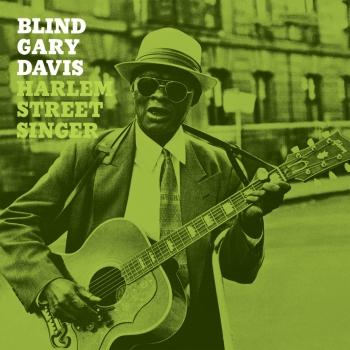Reverend Gary Davis
Biographie Reverend Gary Davis
Reverend (Blind) Gary Davis
was born in Laurens County, S.C., south of Spartanburg, in the Piedmont section of the state. His parents were John and Evelina Davis, who had eight children, six of whom died as babies. A girlfriend killed Davis’ only surviving brother in 1930. Davis claimed to have been born partially blind by chemicals put in his eyes when he was a few weeks old. His grandmother raised Davis, raised chickens, and taught him music.
He began playing the harmonica, and his grandmother helped him make a guitar from a pie pan and a stick. Davis practiced endlessly after his mother gave him a real guitar and learned to play the banjo. His first musical exposure was the spirituals sung in church, square-dance music and popular marches. By the time Davis was ten, he was singing at the Center Raven Baptist Church in Gray Court, South Carolina, playing guitar, banjo, and harmonica for segregated country dances, house parties, and picnics.
By 1940, Davis had found his way to New York City, where he was ordained minister of Missionary Baptist Connection Church. Here, his recording career began in earnest. Starting in the late 1950s, as folk music became popular on campuses and in coffee houses, Davis was "discovered" by a largely educated, middle-class audience. They were at first more interested in his hot guitar licks and blues-holler singing style than in his specific religious message. The Reverend responded to this more secular audience with temporal songs like "Cocaine" and "Baby Let Me Follow You Down" yet also performed gospel compositions like "Samson and Delilah" and "Death Don't Have No Mercy").
Davis always considered his work to be essentially religious. When students traveled uptown to learn from him, Reverend Davis would extend his lesson with preaching, food, and companionship. He became an important mentor to the folk music revival and eventually performed at many festivals, including the Newport Folk Festival and Philadelphia Folk Festival.
By the 1960s, Davis was represented by Folklore Productions, and his songs were published as Chandos Music (ASCAP). They administer the Reverend Gary Davis's Estate. The estate's main beneficiary, the widow Annie Davis, lived for many years in the Reverend’s brick house in Queens, New York.
Davis was an icon of the mid-twentieth-century folk-music revival as one of the most innovative and influential blues guitarists. His legacy as a teacher and performer can be heard in the work of Bob Dylan, the Grateful Dead, and many more. The Reverend Gary Davis died in Hammonton, New Jersey, on May 5, 1972.










